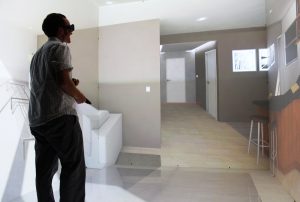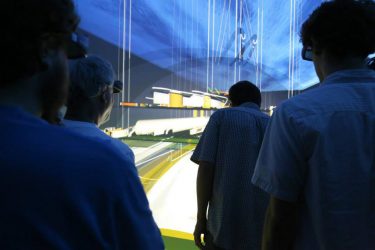Today, virtual reality technologies are being developed and implemented at an unprecedented pace following nearly two decades of stagnation in the field. With the avalanche of technological advances comes an understandable excitement – few tech words have more buzz attached to them than “VR”.
But as researchers and companies around the world race to develop new VR technologies, they are also looking beyond traditional uses – entertainment, for example – to find ways to improve human welfare with VR. One area of VR applications in particular is getting a lot of attention: healthcare.

As VR equipment and software has become more advanced – and more affordable, with companies like Facebook, Samsung, and Microsoft jumping on the VR bandwagon – it has begun to be employed in healthcare contexts from research laboratories to hospital clinics. VR has been used for pain distraction, phobia treatment, high performance training, home healthcare design, and more. Immersive devices like head-mounted displays and specialized virtual reality rooms can display recreated environments including private homes, clinics, and hospital rooms.
These new frontiers in VR application, like many innovations, present new risks alongside their positive potential. Researchers are now beginning debates about the ethics involved in using VR in healthcare and research and what kind of guidelines should be applied to such work.
The Wisconsin Institute for Discovery’s Living Environments Laboratory (LEL) is leading the way in this field by hosting the first-of-its-kind Ethics in Investigational & Interventional Uses of Immersive Virtual Reality Conference (e3iVR) in April. The conference, supported by a grant from the Agency for Healthcare Research and Quality, will provide a framework for a multidisciplinary discussion on ethical issues related to the use of VR and develop and disseminate ethical guidelines based on input from a broad coalition of stakeholders.
Patricia Flatley Brennan is the Director of the National Library of Medicine (NLM) at the National Institutes of Health and the chair of the conference advisory committee. The time for guidelines in healthcare VR, says Brennan, is now:
“Despite the early promise of immersive virtual reality from the 1990’s, the field has languished for almost 20 years, and very little investigational or clinical use of immersive VR occurred. Recent developments in image quality, image capture, display platforms, and inexpensive VR technologies now herald a return of explorations of the research and clinical uses of immersive VR. However, many ethical issues remain unaddressed, including informed consent, integrity of the sense of person, meaningful explanation of side effects and consequences of a VR experience, and fair notification of the extensive data tracking now possible in these systems.”
The Living Environments Laboratory, which Brennan headed before becoming the Director at NLM, is uniquely situated to begin addressing these issues. The lab’s work has run the gamut from experimental work to clinical applications. “During the past six years our group designed and deployed a 6-sided VR CAVE which has been used for basic and applied work including comparison of perception precision in VR and physical spaces, rehabilitation medicine, and home care,” says Erica Gill, Associate Director of LEL and conference facilitator. “We also have hosted over 5,000 people in public tours, industry engagements, educational exercises, and scholarly demonstrations.”
“It is important to have balanced representation from the various stakeholder communities: patients, clinicians, researchers, ethicists, industry, and technical experts.” – Erica Gill
Recognizing the need for a systematic consideration of ethics, Gill and her colleagues drafted a proposal for a conference that was ultimately funded by the Agency for Healthcare Research and Quality. The conference is in two parts, split across two days. E3iVR begins with a series of public talks the afternoon of Wednesday, April 26, featuring experts on the use of VR in clinical and research settings and on ethics in general.
Also present at the talks will be a diverse workgroup, who will spend the second part of e3iVR designing ethical guidelines that will ultimately be shared with the broader research, medical, and patient communities.
“This conference will be unique in the composition of attendees and the focus on the use of VR in the clinical and research setting,” says Gill. “It is important to have balanced representation from the various stakeholder communities: patients, clinicians, researchers, ethicists, industry, and technical experts.”
The structure of the conference reflects that balance – and brings the broader community into the fold as well, before narrowing the focus onto the carefully selected workgroup. “The series of public talks on the first day will both serve as a way to share information about this emerging technology with the general public, and ensure a baseline level of understanding of the key issues before the workgroup participants move into their more detailed discussions,” says Gill.
Those deliberations will produce new guidelines that address issues like informed consent, clarification of risk, and estimation of benefit – all critical concerns when using new technologies with human subjects and patients. Finally, the guidelines for the investigational and interventional use of virtual reality will be widely disseminated for discussion and adoption.
E3iVR will not be the end of the conversation, but it is an important step toward forming a consensus about best practices. “The field is still relatively new,” says Gill. “At times there will be more questions than answers. Our goal is to contribute to the ongoing conversation in the spirit of helping individuals exercise their freedom to participate in novel scientific research and clinical interventions in an informed way.”
Find out more about the conference and register to attend the public talks on the conference website: go.wisc.edu/e3iVR.
-Nolan Lendved


You must be logged in to post a comment.